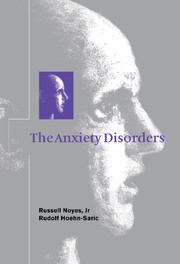Book contents
- Frontmatter
- Contents
- Preface
- 1 Normal anxiety and fear: psychological and biological aspects
- 2 Generalized anxiety disorder
- 3 Panic disorder and agoraphobia
- 4 Social phobia
- 5 Specific phobia
- 6 Posttraumatic stress disorder
- 7 Anxiety in the medically ill: disorders due to medical conditions and substances
- Index
1 - Normal anxiety and fear: psychological and biological aspects
Published online by Cambridge University Press: 22 March 2010
- Frontmatter
- Contents
- Preface
- 1 Normal anxiety and fear: psychological and biological aspects
- 2 Generalized anxiety disorder
- 3 Panic disorder and agoraphobia
- 4 Social phobia
- 5 Specific phobia
- 6 Posttraumatic stress disorder
- 7 Anxiety in the medically ill: disorders due to medical conditions and substances
- Index
Summary
Definition
Anxiety is a universal experience and, as such, is a part of the human condition. It serves as a biological warning system that is activated by danger. It may also occur following loss or may arise from intrapsychic conflict, as in conflict between inner drives and external demands or between conflicting value systems. Anxiety is a distressing emotion usually associated with bodily discomfort. In contrast to depression, which is a reaction to loss and is oriented toward the past, anxiety is a reaction to threat and is directed toward the future. The threat may involve danger, lack of support or what is unknown. Normal anxiety prepares the individual for a protective response. Low levels of anxiety are helpful in coping with adversity, but high levels cause impairment and can even be disorganizing. Anxiety becomes abnormal when its intensity and duration are disproportionate to the potential for harm, when it occurs in situations known to be harmless, or occurs without any recognizable threat.
Anxiety is a complex experience consisting of both psychic and somatic manifestations and hyperarousal. In addition, behavioral reactions are frequently present as well (Hoehn-Saric et al., 1995). Psychic manifestations consist of affective reactions ranging from tension to fear and, in the extreme, full-fledged panic. Cognitive aspects include uneasiness about how to deal with situations and uncertainty about the future. They also include worry, fear, anticipation of disaster, fear of being unable to cope with circumstances, and fear of developing anxiety and, as a result, embar-rassing oneself in public. Anger is related to anxiety and a decrease in the former may result in a corresponding reduction in the latter (Deffenbacher et al., 1986).
- Type
- Chapter
- Information
- The Anxiety Disorders , pp. 1 - 36Publisher: Cambridge University PressPrint publication year: 1998
- 1
- Cited by

